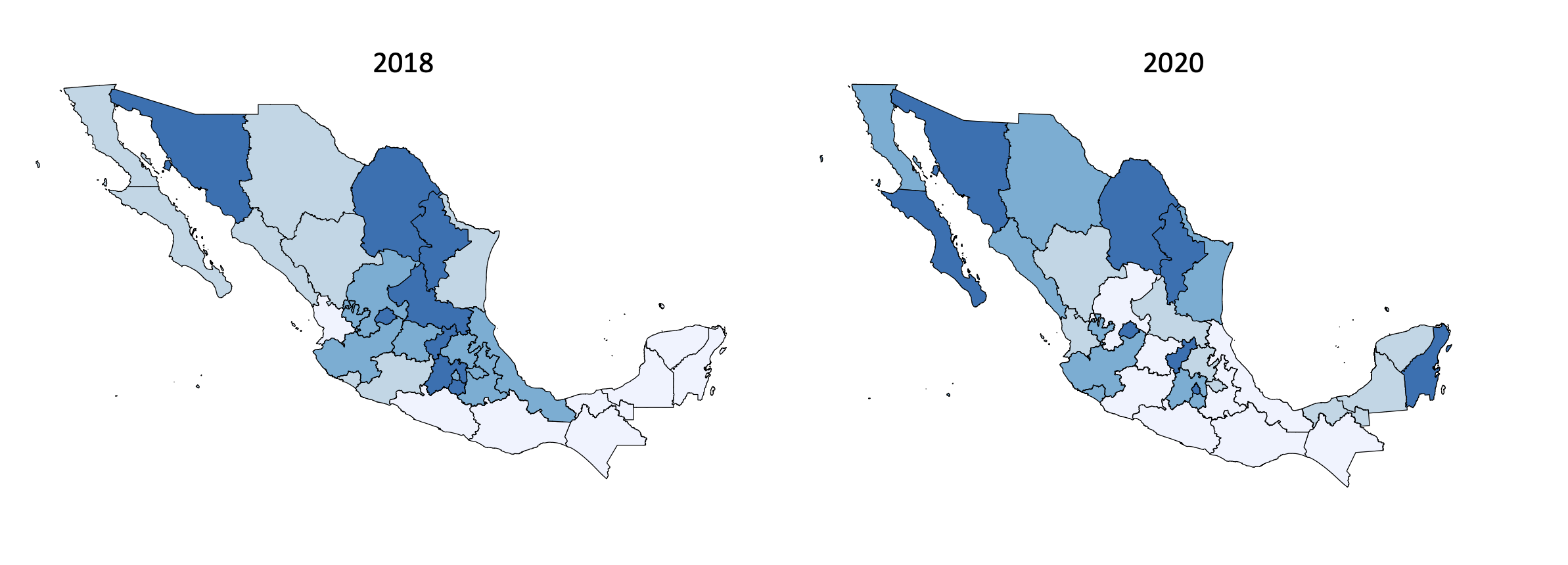Why Education Reform in Mexico Is Critical to Boosting Future Productivity and Economic Growth

Table of Contents
Author(s)
Share this Publication
- Print This Publication
- Cite This Publication Copy Citation
Jesús Antonio López Cabrera, "Why Education Reform in Mexico is Critical to Boosting Future Productivity and Economic Growth" (Houston: Rice University’s Baker Institute for Public Policy, October 18, 2022), https://doi.org/10.25613/V84X-6G54.
Introduction
On December 12, 2018, Mexican President Andrés Manuel López Obrador signed into law a bill that modified several existing laws related to the Mexican public education system. In doing so, López Obrador fulfilled one of his campaign promises to the teachers union,[1] which adamantly opposed the previous 2013 Education Reform Act signed into law by former Mexican President Enrique Peña Nieto. The teachers union felt that the 2013 law restricted the union’s influence over the education system and limited its political activity. Specifically, the law curbed the union’s ability to determine who was hired, who got to keep their job, and how its members were compensated and promoted, regardless of how they were evaluated.
In effect, López Obrador’s law was a “counter-reform” that repealed the 2013 Education Reform Act. It has changed the way teachers are hired, promoted and compensated, ensuring that performance evaluations are no longer a determining factor.[2] Moreover, López Obrador’s counter-reform eliminated the Mexican Institute for the Assessment and Evaluation of Education (INEE, in Spanish), which was charged with evaluating teachers’ performance, and instead created the National Commission for the Continuous Improvement of Education (MEJOREDU, in Spanish). This new agency has limited ability to evaluate the education system and has essentially been turned it into a commission charged with providing information on the system, but little else.
The counter-reform bill went into effect on September 27, 2019. Critics of the new law expected the quality of public education to decline and the gap between public and private education to widen. They also predicted a negative impact on Mexico’s poorest households, which heavily rely on the public education system. These concerns are valid, and there are further worries about the potential impact the law could have on the nation’s overall economic performance.
This brief explores how López Obrador’s educational counter-reform could negatively affected Mexico’s economy — including its productivity, economic growth and ability to attract foreign investment.
Economic Growth, Education and Productivity
Between 2011 and 2018, prior to the COVID-19 pandemic, Mexico’s annual economic growth rate hovered at around 2.7%. This modest growth rate significantly dropped during the pandemic, and it has yet to recover. The fall was so dramatic that experts suggest that Mexico’s gross domestic product (GDP) today stands at about the 2017 level, and its GDP per capita looks more like that of 2014.[3] Regardless of the pandemic’s effects on the economy in recent years, some studies have shown a close relationship between the modesty of Mexico’s economic growth and low productivity levels in Mexico.[4] Productivity means, in simple terms, how many resources go into the production of a unit of output value. If fewer resources go into producing a unit of output value, or if there is an increase in the number and value of units of output using the same resources, then productivity is on the rise. In other words, increased productivity usually translates into more units of output value — that is, economic growth. This is important because productivity is correlated with having skilled, educated workers.
The role of a highly educated populace as a necessary condition for increasing productivity has been extensively discussed in economic theory. Some authors have shown that education improves individual work skills and problem-solving capacity, as workers are better able to learn new technologies and adapt to changes in the workplace.[5] Learning new skills across the board has spillover effects on other individuals by increasing the overall human capital available to employers and making better use of physical capital invested in a given industry. This means that education is a key factor that facilitates technological diffusion, and, as a result, productivity is boosted.[6] Furthermore, education makes the transfer of knowledge among workers and across generations possible,[7] resulting in higher growth and better conditions for all.
Empirical studies of these correlations are common. They use various approaches and statistical techniques — including different time periods, variables, data processing techniques, aggregation levels and datasets (i.e., from a single country or a set of countries). The evidence is consistent. Results show a positive relationship between education and productivity, and when a negative correlation is found, it generally has a fairly reasonable explanation that discounts the value of the outlier studies. In general, these studies present difficulties when correctly measuring or estimating the human capital generated by education.[8] But the most important finding in the literature is that, in general, the relationship between education and productivity is robust and statistically significant.
Education and Economic Growth Performance in Mexico
To be sure, it is difficult to make generalizations, as Mexico is a large country. It is well known that educational performance levels vary across states. There are also differences in economic growth regionally and across states. This is partly driven by the differentiated sectoral specialization of each state.[9] States located at the northern region, near the U.S.-Mexico border, perform better than those located in southern Mexico. Also, states located in central Mexico have better economic performance than those in the central-northern or southern regions. Interestingly, a dissimilar pattern follows when we juxtapose educational performance.
The following maps show the average years of schooling and manufacturing labor productivity by state across Mexico (Figure 1). States marked in darker blue indicate higher average years of schooling or higher manufacturing labor productivity. The map on the right shows the average years for 2020, while the map on the left depicts 2018 manufacturing labor productivity data. The pattern is clear: The higher the average years of schooling, the better the economic performance. Northern border states have higher education levels and perform better economically, for example. This is ultimately why López Obrador’s counter-reform of the education system matters.
Figure 1 — Mexico: Average Years of Schooling by States and Manufacturing Labor Productivity, 2018 and 2020

Potential Damages of the Education Counter-reform to Mexico’s Economic Growth
For several years, big business has been relocating key parts of the global value chain closer to the principal markets they are supplying. Supply chain interruptions are one of the principal arguments in favor of this relocation. The growing cost of doing business overseas, the need to build supply chain resiliency and the arrival of tax benefits programs are additional arguments explaining why businesses favor reshoring and near-shoring of their activities.
But to invest, businesses need to find skilled workers in the country they’re based in. This is not easy, and it is part of a difficult calculation. Recent studies have shown that significant difficulties exist in finding and hiring qualified personnel in manufacturing.[10] Mexico’s lack of qualified, highly educated personnel puts it at a disadvantage when trying to attract new investments to take full advantage of reshoring and near-shoring. Reverting back to an education system that does not incentivize performance adds to this disadvantage. It is necessary to reinforce the quality of education through good education evaluation systems — which the 2013 law intended to do. Having a good system of evaluation for Mexico’s education system would have spillover effects on the economy, increasing productivity and making Mexico more competitive and attractive to foreign investors. The 2018 counter-reform bill takes the country in the opposite direction, hurting its economic future.
Conclusion
It is true that there is a need for a national public policy strategy to elevate Mexico’s education system — especially in the southern part of Mexico where educational outcomes are lagging. Regional disparities also point to the need to invest more in public education. But in order for this investment to work, teachers must be held accountable for their performance in the classroom. López Obrador’s 2018 counter-reform fails to do this, and consequently hurts Mexico’s productivity and economic growth.
Endnotes
[1] Leonardo Kourchenko, “Contrarreforma educativa,” El Financiero, December 13, 2018, https://www.elfinanciero.com.mx/opinion/leonardo-kourchenko-la-aldea/contrarreforma-educativa/.
[2] Redacción, “Esto es lo que cambio la contrarreforma educativa de AMLO,” Cuestione, September 30, 2019, https://cuestione.com/nacional/esto-es-lo-que-cambio-la-contrarreforma-educativa-de-amlo/.
[3] México, ¿cómo vamos?, “Boletín semanal,” August 22, 2022.
[4] Eduardo Bolio et al., A Tale of Two Mexicos: Growth and Prosperity in a Two-speed Economy, McKinsey & Company, March 2014, https://www.mckinsey.com/featured-insights/americas/a-tale-of-two-mexicos; Comisión Económica para América Latina y el Caribe, Productividad y brechas estructurales en México, 2016, https://www.cepal.org/es/publicaciones/40165-productividad-brechas-estructurales-mexico.
[5] Theodore W. Shultz, “The value of the ability to deal with disequilibria,” Journal of Economic Literature 13, no. 3 (1975): 827–846; Erick Rangel González and Luis Fernando López Ornelas, “Inversión extranjera directa y productividad laboral en la industria manufacturera regional,” EconoQuantum 19, no. 1 (January - June 2022): 20–52.
[6] Richard R. Nelson and Edmund S. Phelps, “Investment in humans, technological diffusion and economic growth,” The American Economic Review 56, no. 1/2 (March 1966): 69–75.
[7] Michael Kremer and James Thomson, “Why Isn't Convergence Instantaneous? Young Workers, Old Workers, and Gradual Adjustment,” Journal of Economic Growth 3, no. 1 (March 1998): 5–28.
[8] Angel de la Fuente, “Human Capital and Productivity,” Nordic Economic Policy Review, no. 2 (2011): 103–31.
[9] Government of Mexico, “Programa para Democratizar la Productividad 2013-2018,” Ordinance Mexico City, 2013.
[10] Banco de México, “Los Millennials en el Mercado Laboral: Hechos Estilizados y Opinión Empresarial,” Extracto del Reporte sobre las Economías Regionales, April-June 2017, Box 2: 21-23.
This material may be quoted or reproduced without prior permission, provided appropriate credit is given to the author and Rice University’s Baker Institute for Public Policy. The views expressed herein are those of the individual author(s), and do not necessarily represent the views of Rice University’s Baker Institute for Public Policy.



